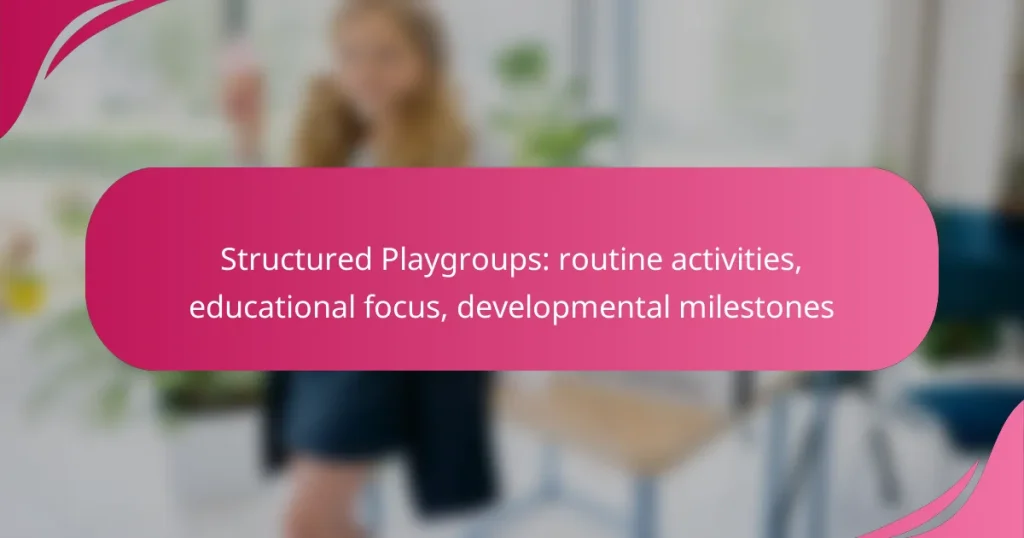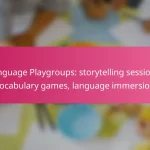Structured playgroups provide a valuable environment for children to engage in guided activities that foster social interaction and developmental growth. By following a consistent routine, these groups incorporate educational elements that support various milestones, including cognitive, emotional, and physical development. Through creative expression, physical movement, and peer interactions, children can enhance essential skills while enjoying the benefits of structured play.

What are structured playgroups?
Structured playgroups are organized settings where children engage in guided activities designed to promote social interaction, learning, and development. These groups typically follow a routine that incorporates educational elements to support various developmental milestones.
Definition of structured playgroups
Structured playgroups are gatherings of young children, often led by trained facilitators, where activities are planned to foster developmental skills. These groups provide a balance of free play and structured activities, allowing children to explore while also learning specific concepts.
In these settings, children participate in various activities that may include arts and crafts, storytelling, and physical play, all aimed at enhancing their cognitive, social, and emotional skills. The structured nature ensures that each session has a clear focus, which can vary from week to week.
Key characteristics of structured playgroups
One key characteristic of structured playgroups is their routine. Sessions typically have a consistent schedule that includes time for free play, guided activities, and group discussions. This predictability helps children feel secure and understand what to expect during each meeting.
Another important aspect is the educational focus. Activities are designed to align with developmental milestones, such as improving fine motor skills through crafts or enhancing language skills through storytelling. Facilitators often assess children’s progress to tailor activities that meet their individual needs.
Finally, structured playgroups encourage socialization. Children learn to interact with peers, share, and cooperate, which are essential skills for their overall development. Parents often appreciate the opportunity for their children to engage in a supportive environment that promotes both learning and play.
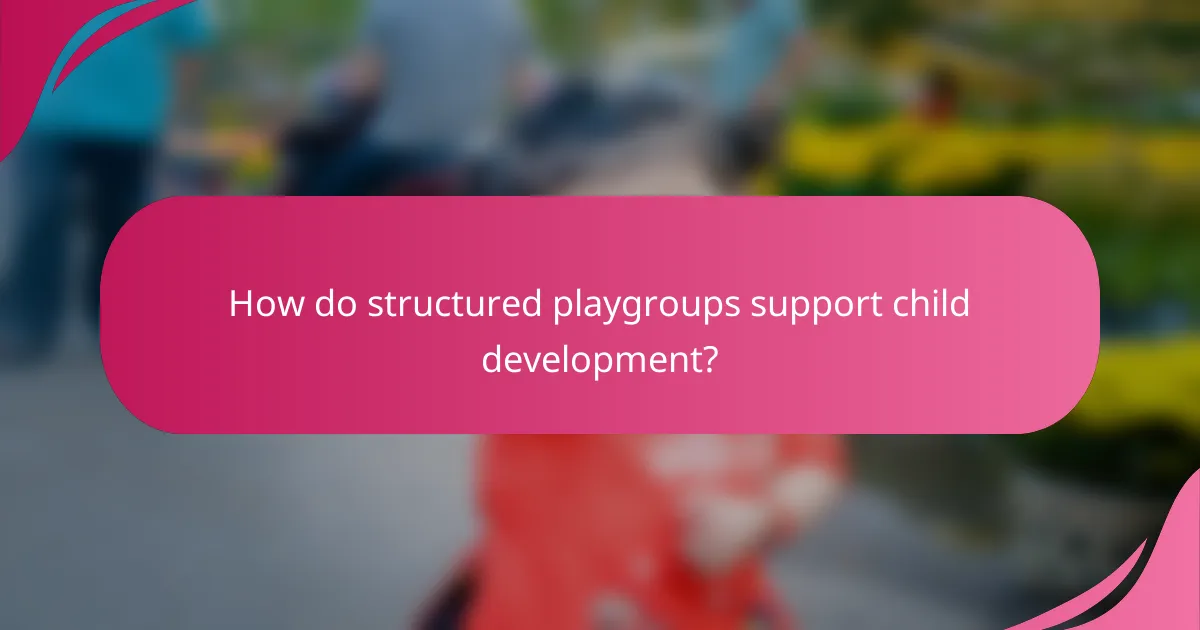
How do structured playgroups support child development?
Structured playgroups significantly enhance child development by providing a framework for social interaction, cognitive challenges, and emotional growth. These organized settings encourage children to engage in activities that promote essential skills through guided play and peer interactions.
Enhancing social skills
Structured playgroups create opportunities for children to interact with peers, which is crucial for developing social skills. Through cooperative games and group activities, children learn to share, take turns, and communicate effectively. These interactions help them understand social cues and build friendships.
For example, activities like group storytelling or team-based games encourage children to express their thoughts and listen to others. Parents can support this development by encouraging their children to participate in diverse playgroups, which expose them to different social dynamics.
Promoting cognitive development
Structured playgroups also play a vital role in promoting cognitive development by incorporating educational activities that stimulate critical thinking and problem-solving. Activities such as puzzles, building blocks, and arts and crafts challenge children to think creatively and develop their reasoning skills.
To maximize cognitive benefits, parents should look for playgroups that include a variety of learning activities tailored to different age groups. Engaging in these activities not only enhances cognitive abilities but also prepares children for future academic success by fostering a love for learning in a fun environment.
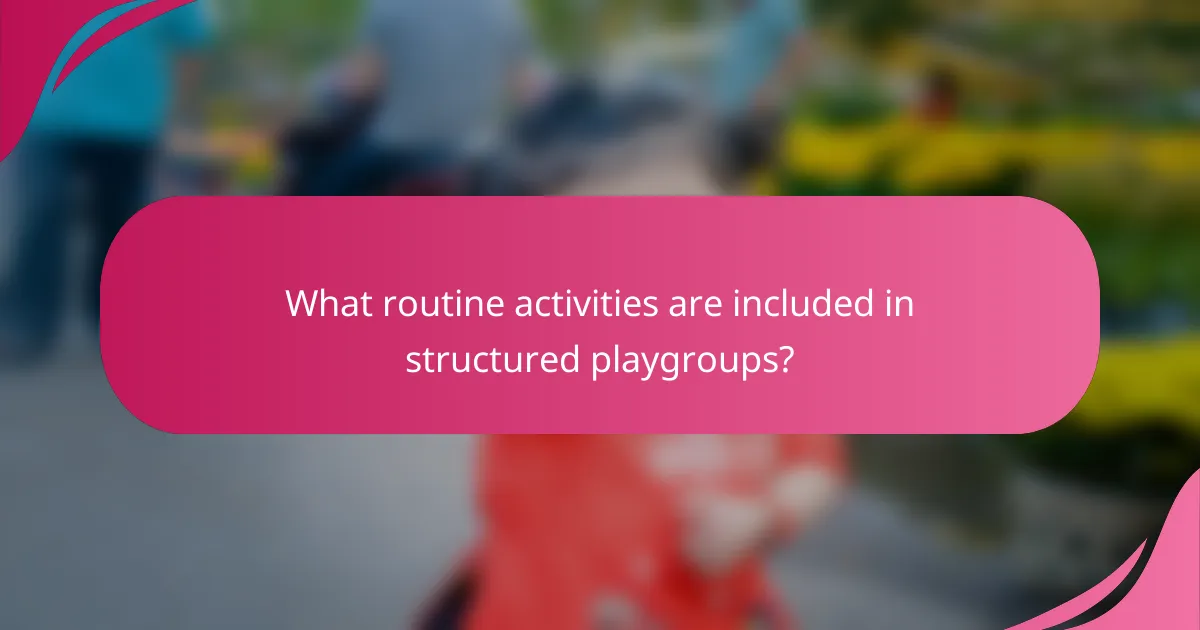
What routine activities are included in structured playgroups?
Structured playgroups typically incorporate a variety of routine activities designed to promote learning and development in young children. These activities often focus on creative expression, physical movement, and social interaction, helping children achieve key developmental milestones.
Creative arts and crafts
Creative arts and crafts activities in structured playgroups encourage children to express themselves and develop fine motor skills. Common activities include painting, drawing, and crafting with materials like paper, clay, and recycled items.
When planning these activities, consider providing a range of supplies to stimulate creativity. For example, using different textures, colors, and tools can enhance the experience. It’s beneficial to allow children to explore freely while guiding them with simple techniques.
Physical play and movement
Physical play and movement activities are essential in structured playgroups, as they promote gross motor skills and overall physical health. Activities may include obstacle courses, dancing, and group games that encourage movement and coordination.
To maximize engagement, incorporate varied physical activities that cater to different skill levels. For instance, simple games like tag or relay races can be adapted for younger children. Ensure that the play environment is safe and spacious enough to accommodate active play, allowing children to explore their physical capabilities.
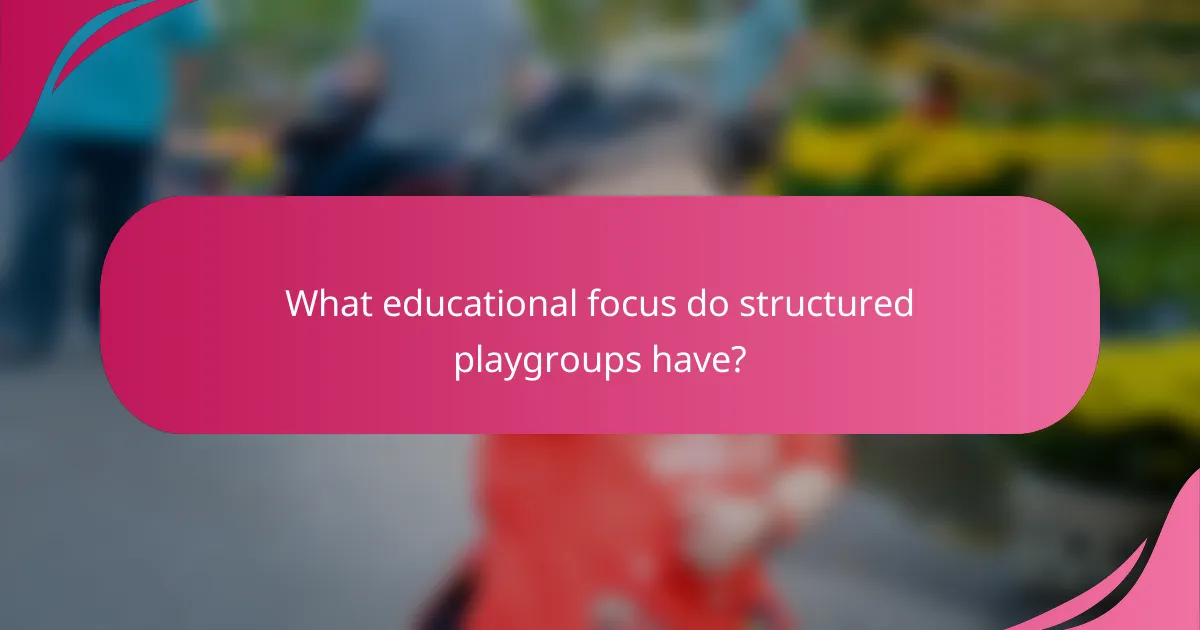
What educational focus do structured playgroups have?
Structured playgroups primarily focus on fostering essential developmental skills through organized activities. These groups aim to enhance children’s learning in areas such as language, STEM, and social interactions, all while providing a safe and engaging environment.
Language development activities
Language development activities in structured playgroups are designed to enhance vocabulary, comprehension, and communication skills. Common methods include storytelling, singing songs, and engaging in interactive dialogues that encourage children to express themselves.
For effective language development, activities often incorporate visual aids and props to make learning more engaging. For instance, using picture books or flashcards can help children associate words with images, reinforcing their understanding.
Parents should look for playgroups that emphasize regular language activities, as consistent exposure can significantly boost a child’s linguistic abilities. Avoid groups that lack structured language components, as these may not provide the necessary stimulation for growth.
STEM learning opportunities
STEM learning opportunities in structured playgroups focus on introducing basic concepts of science, technology, engineering, and mathematics through hands-on activities. These may include simple experiments, building projects, and age-appropriate math games that encourage critical thinking.
For example, children might engage in activities like measuring ingredients for a recipe or constructing simple structures with blocks. Such experiences help develop problem-solving skills and an early interest in STEM fields.
When selecting a playgroup, ensure that STEM activities are integrated into the curriculum. Look for programs that offer a variety of engaging projects, as this can foster a lifelong love for learning in these critical areas.
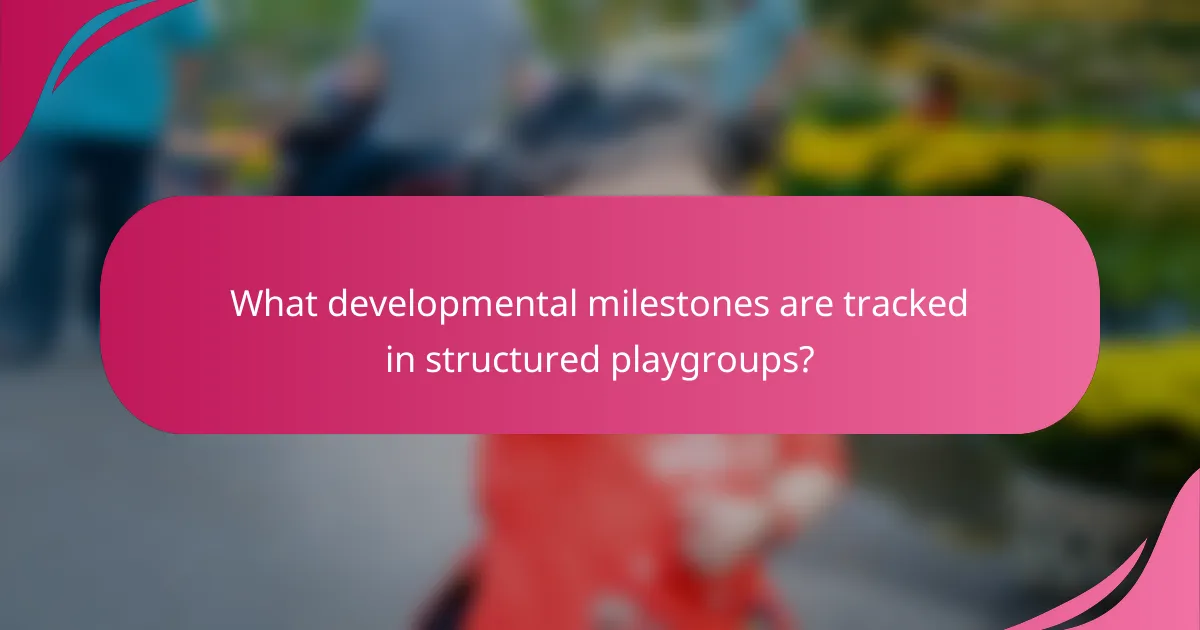
What developmental milestones are tracked in structured playgroups?
Structured playgroups track various developmental milestones to support children’s growth in a social environment. These milestones typically encompass social-emotional skills, physical development, and cognitive abilities, helping caregivers and educators assess progress and tailor activities accordingly.
Social-emotional milestones
Social-emotional milestones focus on how children interact with others and manage their emotions. Key indicators include sharing, taking turns, and expressing feelings appropriately. By age three, many children begin to show empathy and can recognize emotions in peers.
Structured playgroups provide opportunities for children to practice these skills in a guided setting. Activities such as group games and collaborative projects encourage positive interactions and help children develop conflict resolution strategies.
Physical development milestones
Physical development milestones assess both gross and fine motor skills. Gross motor skills involve larger movements, such as running and jumping, while fine motor skills include tasks like drawing or manipulating small objects. By age four, children typically can hop on one foot and use scissors with some proficiency.
In structured playgroups, activities like obstacle courses and arts and crafts promote physical development. Caregivers should observe children’s abilities and provide appropriate challenges to encourage skill enhancement without frustration.

How can parents choose the right structured playgroup?
Parents can choose the right structured playgroup by evaluating the educational focus, routine activities, and developmental milestones offered. It’s essential to consider how these elements align with a child’s needs and family values.
Factors to consider when selecting a playgroup
When selecting a playgroup, parents should assess the program’s educational philosophy, such as whether it emphasizes play-based learning or structured curricula. Additionally, consider the group size, staff-to-child ratio, and the qualifications of the educators involved.
Location and schedule are also crucial. A playgroup that is conveniently located and offers flexible hours can significantly enhance participation. Look for programs that provide a variety of activities that promote social, emotional, and cognitive development.
Questions to ask playgroup providers
Parents should ask playgroup providers about their curriculum and how it supports developmental milestones. Inquire about the types of activities offered, such as arts and crafts, physical play, and group games, to ensure they align with your child’s interests.
It’s also important to ask about safety protocols, including staff training in first aid and emergency procedures. Understanding how the playgroup communicates with parents and tracks children’s progress can provide additional peace of mind.

What are the benefits of structured playgroups in urban areas?
Structured playgroups in urban areas provide children with a variety of developmental benefits, including enhanced social skills and access to educational resources. These groups create an environment where children can learn through play while fostering connections among families in the community.
Access to diverse resources
Structured playgroups often have access to a wide range of educational materials and activities that cater to different developmental stages. This can include art supplies, books, and interactive games that promote learning in a fun way. Urban areas may offer additional resources such as local libraries, museums, and parks that can be integrated into playgroup activities.
Parents can also benefit from workshops and informational sessions provided by playgroups, which can cover topics like child development, nutrition, and parenting strategies. These resources help parents make informed decisions about their children’s growth and education.
Community building opportunities
Structured playgroups serve as a platform for families to connect and build relationships within their urban communities. By participating in these groups, parents can meet others who share similar interests and challenges, fostering a support network that can be invaluable. This sense of community can lead to lasting friendships and collaborative parenting approaches.
Additionally, playgroups often organize events and outings that encourage family involvement and strengthen community ties. Activities like picnics, seasonal celebrations, and volunteer opportunities can enhance the sense of belonging and shared purpose among families in the area.
